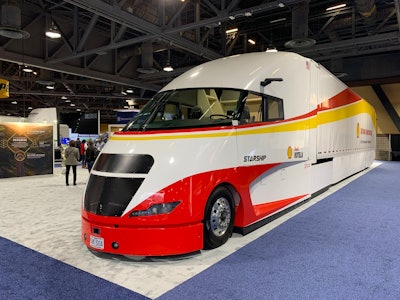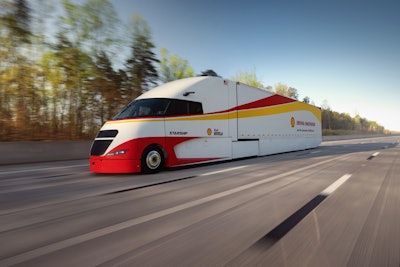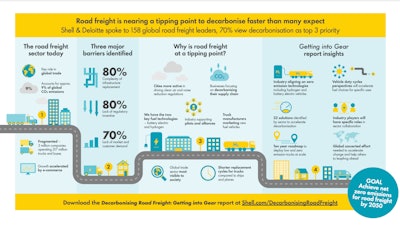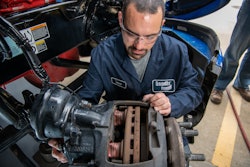
Shell announced today that its high-efficiency Starship 2.0 truck demonstrator had big gains in fuel economy and freight ton efficiency over its 2018 predecessor, Starship 1.0.
A regional trip, which followed the long-haul journey, was even more impressive with nearly double the mpg and triple the freight-ton efficiency of the U.S. average. Both trips were monitored and verified by the North American Council for Freight Efficiency.
Following the same long-haul route that Starship 1.0 took in 2018 from San Diego, Calif. to Jacksonville, Fla., Starship 2.0 saw a nearly 21% gain in fuel economy at 10.8 mpg compared to Starship 1.0’s 8.94 mpg. Average fuel economy for a Class 8 North American tractor-trailer is 6.4 mpg, according to Shell, which is roughly 40% lower than Starship 2.0.
 In addition to impressive fuel economy gains, Shell reports that Starship 2.0 can drop CO2 emissions in a big way.
In addition to impressive fuel economy gains, Shell reports that Starship 2.0 can drop CO2 emissions in a big way.
"One of the most important metrics achieved by Shell Starship 2.0 is the potential reduction in CO2 emissions for the fleet industry," the company states. "If every truck in North America could be as efficient as the Shell Starship 2.0, this could mean a potential reduction in CO2 emissions for North America of 275 million tons annually."Shell
[Related: Starship and SuperTruck reveal diesel's staying power]
Starship 2.0’s freight ton efficiency performance gains came even as it hauled 18% more payload than Starship 1.0. Both trucks hauled artificial reefs to be used off Jacksonville’s Atlantic coast. Starship 2.0’s load came in at 47,100 pounds while Starship 1.0’s reef material weighed in at 39,900 pounds.
Though the two trucks may look similar, Starship 2.0 came with some big changes including a 2020 Cummins X15 400 EX Efficiency Series engine paired up with a 12-speed Eaton Endurant transmission.
“In essence, the only thing that has been retained from the original truck is the carbon fiber cab design because the aerodynamics in that could really not really be improved upon,” said Jeff Priborksy, Shell’s on-highway global marketing manager.
Starship 2.0 project manager Ryan Manthiri explained that the truck’s stellar performance gains came as a result of a collaborative effort among various engineers and manufacturers some of whom were present with Manthiri at the Advanced Clean Transportation Expo in Long Beach, Calif. this week.
With all the careful analysis and planning that went into Starship 2.0, did the results from the 2,340-mile trip really prove surprising?
“I think yes and no,” Manthiri said. “There were a lot of things we learned from the first truck. The increase that we saw, 254 ton miles, I think that was a bit of a surprise in terms of just how big the efficiency improvement was.”
Selda Gunsel, Shell’s vice president of global lubricants and fuels technology, said results with Starship 2.0 proved exciting.
“I think we expected improvements because as you mentioned we used the latest version of the energy efficient Cummins engine and the Eaton transmission,” Gunsel said. “We used our latest low viscosity lubricants. We expected improvements through the new tires and all the other improvements around aerodynamics.
 Shell Starship 2.0 uses Shell Rotella T6 Ultra 5W-30 Full Synthetic engine oil which features a high temperature high shear (HTHS) viscosity formulation for reduced fuel consumption.Shell
Shell Starship 2.0 uses Shell Rotella T6 Ultra 5W-30 Full Synthetic engine oil which features a high temperature high shear (HTHS) viscosity formulation for reduced fuel consumption.Shell
Regional haul renders big results
Long-haul results were so encouraging, Manthiri said, that Shell opted to test the truck on a regional 400-mile route in North Carolina with a cargo weight of 17.5 tons. Average fuel economy during that trip was 12 mpg, or nearly double the U.S. average of 6.4 mpg. Freight ton efficiency came in at 72 ton-miles per gallon which is more than triple the U.S. average for regional haul.“The efficiency testing with different payloads and miles driven demonstrate that efficient technologies have significant benefits for long-haul and shorter regional-haul applications,” said Robert Mainwaring, technology manager for innovation at Shell Lubricants. “Fleets and owner-operators can evaluate which technologies are most beneficial for them and pursue them today to find significant fuel savings and carbon emissions reductions.”
Manthiri said fleets and owner-operators can turn to the technologies on Starship 2.0 today to get better fuel economy and a smaller carbon footprint.
“I think the main purpose or takeaway from this demonstration is that it triggers conversation around what we’ve just done,” Manthiri said. “We’ve gone out and proven it twice now that significant change is possible utilizing off the shelf technologies.”













